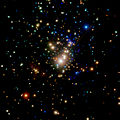Trapezium Cluster
| Trapezium | |
|---|---|
 | |
| Observation data (J2000 epoch) | |
| Right ascension | 05h 35.4m |
| Declination | −05° 27′ |
| Distance | 1,344±20 ly (412 pc[1]) |
| Apparent magnitude (V) | 4.0 |
| Apparent dimensions (V) | 47 (seconds of arc) |
| Physical characteristics | |
| Mass | ? M☉ |
| Radius | 10 ly |
| Estimated age | 300,000 years |
| Associations | |
| Constellation | Orion |
The Trapezium or Orion Trapezium Cluster, also known by its Bayer designation of Theta1 Orionis, is a tight open cluster of stars in the heart of the Orion Nebula, in the constellation of Orion. It was discovered by Galileo Galilei. On 4 February 1617 he sketched three of the stars (A, C and D), but missed the surrounding nebulosity.[2][3][4] A fourth component (B) was identified by several observers in 1673, and several more components were discovered later like E, for a total of eight by 1888. Subsequently, several of the stars were determined to be binaries. Telescopes of amateur astronomers from about 5-inch (130 mm) aperture can resolve six stars under good seeing conditions.[5]
The Trapezium is a relatively young cluster that has formed directly out of the parent nebula. The five brightest stars are on the order of 15 to 30 solar masses in size. They are within a diameter of 1.5 light-years of each other and are responsible for much of the illumination of the surrounding nebula. The Trapezium may be a sub-component of the larger Orion Nebula Cluster, a grouping of about 2,000 stars within a diameter of 20 light-years.
Identification
The Trapezium is most readily identifiable by the asterism of four relatively bright stars for which it is named. The four are often identified as A, B, C and D in order of increasing right ascension. The brightest of the four stars is C, or Theta1 Orionis C, with an apparent magnitude of 5.13. Both A and B have been identified as eclipsing binaries.
Infrared images of the Trapezium are better able to penetrate the surrounding clouds of dust, and have located many more stellar components. About half the stars within the cluster have been found to contain evaporating circumstellar disks, a likely precursor to planetary formation. In addition, brown dwarfs and low-mass runaway stars have been identified.
Possible black hole
A 2012 paper suggests an intermediate-mass black hole with a mass more than 100 times that of the Sun may be present within the Trapezium, something that could explain the large velocity dispersion of the stars of the cluster.[6]
-
One of the components of the cluster (Theta1 Orionis F, lower left) is a double star.[7]
-
The Chandra X-ray Observatory view of the Orion Nebula
-
Trapezium star identification
-
Hubble detail of a region west of the Trapezium, showing arcs and bubbles formed when stellar winds collide with existing interstellar material
-
A wider shot of the core details showing the trapezium in context of the surrounding nebulae
-
Core detail of the nebula with all the stars identified
List of stars
| Star | Stellar components |
|---|---|
| A |
A1, A2, A3 |
| B |
B1, B2, B3, B4, B5 |
| C |
C1, C2 |
| D |
/ |
| E |
E1, E2 |
| F |
/ |
| G |
/ |
| H |
/ |
References
- ^ Reid, M. J.; et al. (2009). "Trigonometric Parallaxes of Massive Star Forming Regions: VI. Galactic Structure, Fundamental Parameters and Non-Circular Motions". Astrophysical Journal. 700: 137–148. arXiv:0902.3913. Bibcode:2009ApJ...700..137R. doi:10.1088/0004-637X/700/1/137. S2CID 11347166.
- ^ Galileo Galilei: Siderius Nuncius, Venice, 1610. English Translation published at Bard College, Hudson NY" October 9, 2003 English Translation [1] Archived 2004-07-06 at the Wayback Machine Original Latin version [2]
- ^ Tom Pope and Jim Mosher: Galilean telescope homepage" March 17, 2006 "The Trapezium Through the Galilean Telescope". Archived from the original on 2008-01-30. Retrieved 2008-01-30., "Some have expressed puzzlement that in his text Galileo does not mention the nebulosity (known in modern nomenclature as M42) enveloping these stars. ... Galileo believed, as he explains in Sidereus Nuncius, that what looks nebulous to the eye is resolved into stars by his telescope; what looks nebulous through his telescope could presumably also be resolved into stars by a still larger and more powerful telescope. Hence, a diffuse glow would be, more than anything, an indication of the limitations of his telescope and not particularly worthy of special note."
- ^ Tom Pope and Jim Mosher: Page on Galileo's February 4, 1617 notebook drawing of the Trapezium region, May 2, 2006 "Perhaps significantly, Galileo makes no mention of having noticed the now well-known gas cloud, M42, surrounding the Trapezium stars."[3] Archived 2011-08-11 at the Wayback Machine
- ^ "Trapezium Cluster". 15 May 2015. Retrieved 2018-03-06.
- ^ Šubr, L.; Kroupa, P.; Baumgardt, H. (2012-09-04). "Catch me if you can: is there a "runaway-mass" black hole in the Orion Nebula Cluster?". The Astrophysical Journal. 757 (1): 37. arXiv:1209.2114. Bibcode:2012ApJ...757...37S. doi:10.1088/0004-637X/757/1/37. S2CID 118549761.
- ^ "First Light For Future Black Hole Probe". Retrieved 15 January 2016.
Further reading
- Lada, E. A.; et al. (1996). "Circumstellar Disks in the Trapezium Cluster". Bulletin of the American Astronomical Society. 28: 1342. Bibcode:1996AAS...189.5301L.
- Poveda, Arcadio; et al. (2005). "Low-Mass Runaway Stars from the Orion Trapezium Cluster". Astrophysical Journal. 627 (1): L61–L64. arXiv:astro-ph/0506002. Bibcode:2005ApJ...627L..61P. doi:10.1086/432053. S2CID 1145928.
External links
- Chandra Observatory Uncovers Hot Stars In The Making, MIT Press Release, 2000.
- Astronomy Picture of the Day - In the Center of the Trapezium 2003 March 2
- Observing the Trapezium

![One of the components of the cluster (Theta1 Orionis F, lower left) is a double star.[7]](http://upload.wikimedia.org/wikipedia/commons/thumb/d/de/GRAVITY_discovers_new_double_star_in_Orion_Trapezium_Cluster.jpg/120px-GRAVITY_discovers_new_double_star_in_Orion_Trapezium_Cluster.jpg)




